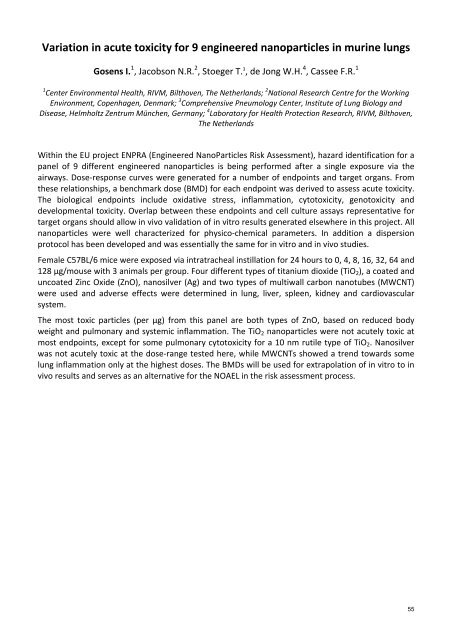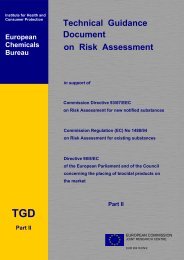Challenges of Regulation and Risk Assessment of Nanomaterials
Challenges of Regulation and Risk Assessment of Nanomaterials
Challenges of Regulation and Risk Assessment of Nanomaterials
You also want an ePaper? Increase the reach of your titles
YUMPU automatically turns print PDFs into web optimized ePapers that Google loves.
Variation in acute toxicity for 9 engineered nanoparticles in murine lungs<br />
Gosens I. 1 , Jacobson N.R. 2 , Stoeger T. 3 , de Jong W.H. 4 , Cassee F.R. 1<br />
1Center Environmental Health, RIVM, Bilthoven, The Netherl<strong>and</strong>s; 2 National Research Centre for the Working<br />
Environment, Copenhagen, Denmark; 3 Comprehensive Pneumology Center, Institute <strong>of</strong> Lung Biology <strong>and</strong><br />
Disease, Helmholtz Zentrum München, Germany; 4 Laboratory for Health Protection Research, RIVM, Bilthoven,<br />
The Netherl<strong>and</strong>s<br />
Within the EU project ENPRA (Engineered NanoParticles <strong>Risk</strong> <strong>Assessment</strong>), hazard identification for a<br />
panel <strong>of</strong> 9 different engineered nanoparticles is being performed after a single exposure via the<br />
airways. Dose-response curves were generated for a number <strong>of</strong> endpoints <strong>and</strong> target organs. From<br />
these relationships, a benchmark dose (BMD) for each endpoint was derived to assess acute toxicity.<br />
The biological endpoints include oxidative stress, inflammation, cytotoxicity, genotoxicity <strong>and</strong><br />
developmental toxicity. Overlap between these endpoints <strong>and</strong> cell culture assays representative for<br />
target organs should allow in vivo validation <strong>of</strong> in vitro results generated elsewhere in this project. All<br />
nanoparticles were well characterized for physico-chemical parameters. In addition a dispersion<br />
protocol has been developed <strong>and</strong> was essentially the same for in vitro <strong>and</strong> in vivo studies.<br />
Female C57BL/6 mice were exposed via intratracheal instillation for 24 hours to 0, 4, 8, 16, 32, 64 <strong>and</strong><br />
128 µg/mouse with 3 animals per group. Four different types <strong>of</strong> titanium dioxide (TiO2), a coated <strong>and</strong><br />
uncoated Zinc Oxide (ZnO), nanosilver (Ag) <strong>and</strong> two types <strong>of</strong> multiwall carbon nanotubes (MWCNT)<br />
were used <strong>and</strong> adverse effects were determined in lung, liver, spleen, kidney <strong>and</strong> cardiovascular<br />
system.<br />
The most toxic particles (per µg) from this panel are both types <strong>of</strong> ZnO, based on reduced body<br />
weight <strong>and</strong> pulmonary <strong>and</strong> systemic inflammation. The TiO2 nanoparticles were not acutely toxic at<br />
most endpoints, except for some pulmonary cytotoxicity for a 10 nm rutile type <strong>of</strong> TiO2. Nanosilver<br />
was not acutely toxic at the dose-range tested here, while MWCNTs showed a trend towards some<br />
lung inflammation only at the highest doses. The BMDs will be used for extrapolation <strong>of</strong> in vitro to in<br />
vivo results <strong>and</strong> serves as an alternative for the NOAEL in the risk assessment process.<br />
55








